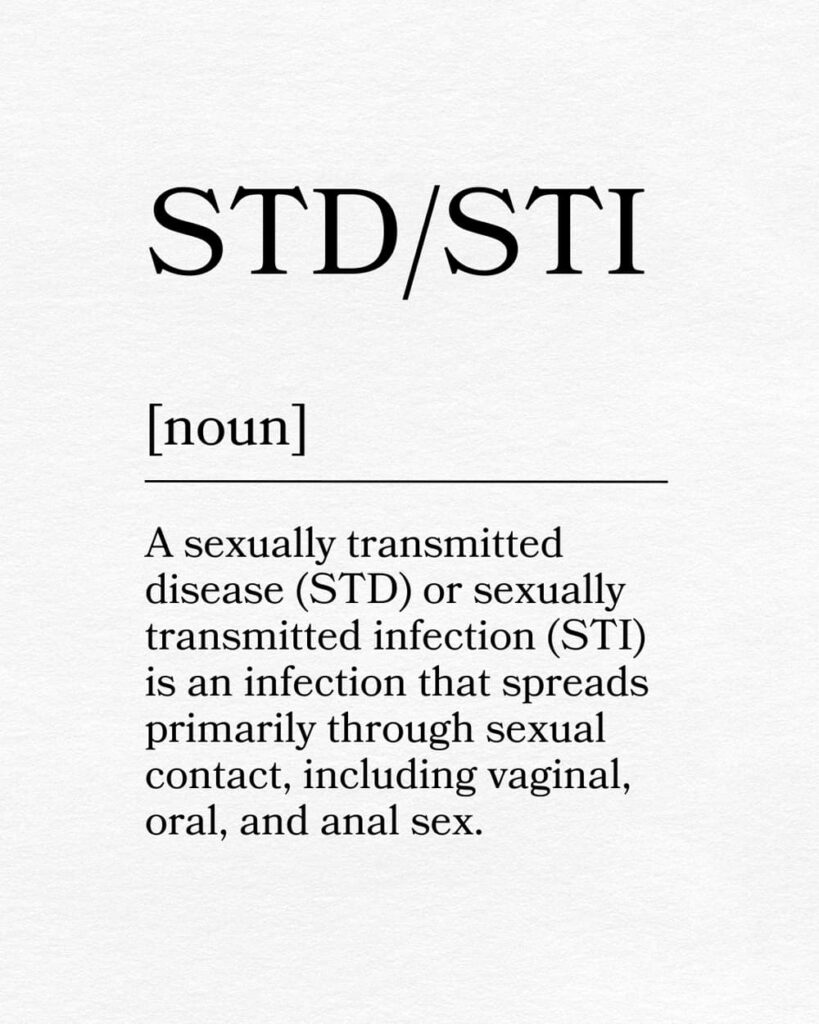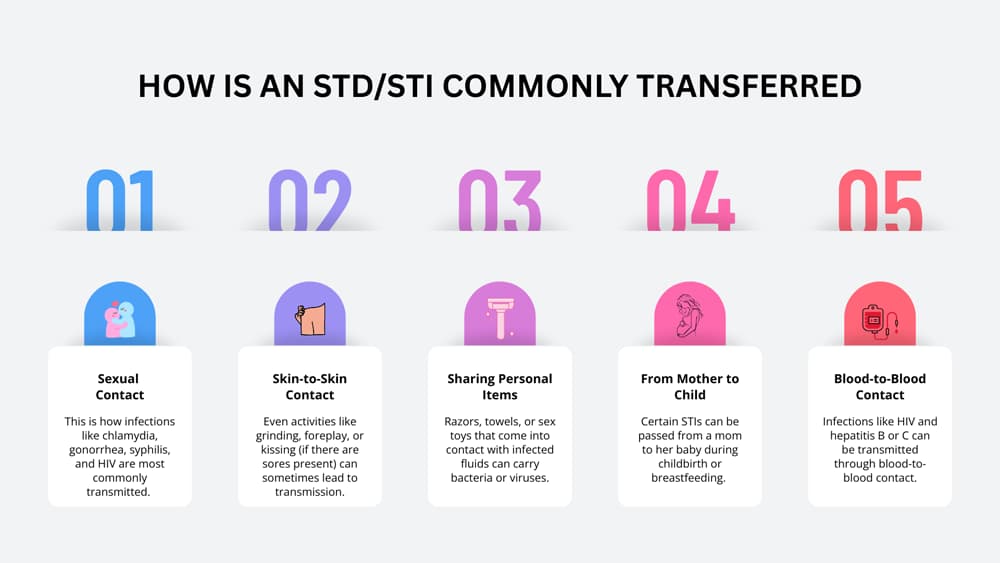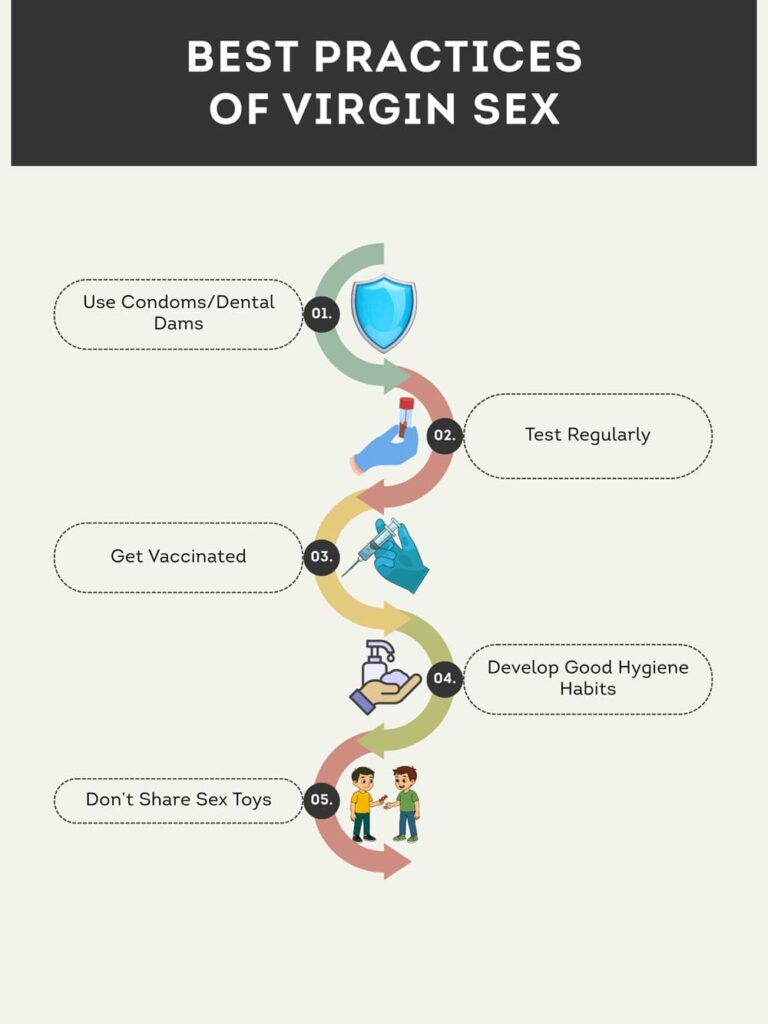When two people who have never had sex before decide to take that intimate step together, they might assume they’re completely safe from sexually transmitted infections (STIs) and diseases (STDs). After all, if neither partner has been sexually active, where would an infection come from? While it’s generally true that two virgins are at very low risk of contracting an STI, there are still some exceptions to be aware of.
In this article, we’ll explore the rare but possible ways STIs can be transmitted between two virgins, discuss the importance of sexual health beyond just past partners, and provide tips on how to stay safe. Whether you’re in a new relationship or just curious about the risks, understanding the facts can help you make informed decisions about your sexual health.
What is an STD/STI?
A sexually transmitted disease (STD) or sexually transmitted infection (STI) is an infection that spreads primarily through sexual contact, including vaginal, oral, and anal sex. These infections are caused by bacteria, viruses, or parasites and can lead to various health complications if left untreated.
While the terms STD and STI are often used interchangeably, there is a slight difference between them. An STI refers to an infection that may not yet have developed into a disease, meaning a person can carry the infection without showing symptoms. An STD, on the other hand, typically refers to an infection that has progressed and is causing noticeable health issues.
Some common STIs include chlamydia, gonorrhea, herpes, human papillomavirus (HPV), syphilis, and HIV. While many STIs are spread through sexual activity, certain infections can also be transmitted through skin-to-skin contact, shared personal items, or even from mother to child during childbirth.

How is an STD/STI Commonly Transferred?
Most people associate STDs and STIs with sexual activity, but not all infections require intercourse to spread. While many STIs are transmitted through sexual contact, others can be passed through skin-to-skin touch, bodily fluids, or even shared personal items. Here’s a breakdown of the most common ways STIs can be transferred:
1. Sexual Contact
The most well-known way STIs spread is through vaginal, oral, or anal sex. This is how infections like chlamydia, gonorrhea, syphilis, and HIV are most commonly transmitted. These infections spread through contact with infected bodily fluids, such as semen, vaginal fluids, and blood.
2. Skin-to-Skin Contact
Some STIs don’t require penetration at all. Infections like genital herpes, human papillomavirus (HPV), and syphilis can be passed simply through skin-to-skin contact with an infected area. This means even activities like grinding, foreplay, or kissing (if there are sores present) can sometimes lead to transmission.
3. Sharing Personal Items
While less common, some infections can be spread through shared objects. Items like razors, towels, or sex toys that come into contact with infected fluids can carry bacteria or viruses and transfer them to another person. This is more common with infections like HPV, herpes, or pubic lice.
4. From Mother to Child
Certain STIs, such as HIV, syphilis, and herpes, can be passed from a pregnant person to their baby during childbirth or breastfeeding. This is why prenatal STI screening is essential for protecting both the parent and the child.
5. Blood-to-Blood Contact
Though not typically considered an STI, infections like HIV and hepatitis B or C can be transmitted through blood-to-blood contact. This can happen through shared needles, unsterilized medical equipment, or even unregulated tattooing and piercing.

Even if both partners are virgins, understanding these transmission methods is essential for maintaining sexual health and avoiding unnecessary risks.
Can Two Virgins Get an STD/STI?
If both partners are virgins—meaning they’ve never had any form of sexual contact with another person—the chances of them transmitting an STD/STI to each other are extremely low. However, “low” doesn’t mean “impossible.” There are still some ways a person might have an infection before ever engaging in sex. Let’s explore a few scenarios where a virgin could unknowingly carry and transmit an STD/STI.
One May Have Asymptomatic Infections Before
Some STIs don’t always show symptoms, meaning a person can be infected without even knowing it. For example, human papillomavirus (HPV), herpes, and even some cases of chlamydia can remain dormant in the body for months or even years. If a person contracted an STI through non-sexual means earlier in life, they might unknowingly carry the infection into their first sexual experience.
One May Get Non-Sexually Infected Before
STIs aren’t always transmitted through sex. Some infections, such as HPV, herpes, and pubic lice, can be contracted through skin-to-skin contact, shared personal items, or exposure to contaminated surfaces. Here are a few unexpected ways someone might get an STI before ever having sex:
- Infected Body Fluids – If a person comes into contact with infected blood or saliva (such as through open wounds, sharing razors, or receiving contaminated medical treatments), they could contract certain infections like hepatitis B or herpes.
- Contaminated Surfaces – Although rare, some STIs may linger on objects like hotel bed sheets, towels, or poorly sanitized medical equipment, increasing the risk of accidental transmission.
One May Get Infected Through Polluted Sex Toys
Even if a person has never had sexual contact with another person, using unclean or shared sex toys can pose a risk of infection. STIs like chlamydia, gonorrhea, HPV, and herpes can live on surfaces for a short time.
If a sex toy is used without proper cleaning or is shared with someone who is unknowingly infected, the infection could be passed along. To reduce this risk, always clean toys thoroughly before and after use, and consider using condoms on shared toys.
Best Practices
Even if the risk of STDs/STIs is low between two virgins, practicing good sexual health habits is always a smart choice. These best practices can help prevent infections, promote safety, and build a healthy foundation for a responsible sex life.
Use Condoms/Dental Dams
Barrier protection, like condoms and dental dams, isn’t just for preventing pregnancy—they also help reduce the risk of STDs/STIs by blocking contact with infected bodily fluids. Even if both partners believe they’re STI-free, using protection can be a great habit to establish from the start.
Test Regularly
Getting tested for STDs/STIs might not seem necessary if both partners are virgins, but regular sexual health screenings are still a good idea. Some infections, like HPV or herpes, don’t always have noticeable symptoms, and testing provides peace of mind. Plus, if either partner has had any non-sexual risk factors (such as sharing razors, medical procedures, or past contact with infected fluids), testing can help catch potential issues early.
Get Vaccinated
Vaccines are available for some of the most common STIs, including HPV and hepatitis B. Getting vaccinated before becoming sexually active is one of the best ways to prevent infections in the future. If you haven’t already received these vaccines, talk to a healthcare provider about your options.
Develop Good Hygiene Habits
Good personal hygiene plays a crucial role in preventing infections. Washing hands, keeping genital areas clean, avoiding shared towels, and practicing safe personal care can all help reduce the risk of contracting or spreading infections. If you shave or groom your intimate areas, make sure to use clean, personal razors to avoid any potential exposure to bacteria or viruses.
Don’t Share Sex Toys
If using sex toys, make sure they are properly cleaned before and after each use. Never share sex toys with a partner unless they are covered with a fresh condom, as infections can spread through contaminated objects. Silicone, glass, or stainless-steel toys should be thoroughly sanitized with warm water and antibacterial soap or a specialized sex toy cleaner.

Taking proactive steps toward sexual health from the very beginning sets the stage for a safe and enjoyable sex life. Even if two virgins are unlikely to transmit an STD/STI, following these best practices can help prevent future risks, build trust in a relationship, and establish lifelong habits that promote well-being.
FAQ
Here are answers to some of the most common questions about STDs/STIs and virginity.
Can Two Virgins Get an STD/STI from Oral Sex?
Yes, it’s possible. Some STIs, like herpes (HSV-1 and HSV-2), HPV, and gonorrhea, can be transmitted through oral sex. If one partner has a cold sore (which is caused by oral herpes), they can pass it to the other partner’s genitals.
Even if both partners are virgins, oral infections from childhood or non-sexual contact can still be a risk. Using a dental dam or condom during oral sex can help lower this risk.
Can Two Virgins with Negative Test Results Get an STD/STI?
It’s unlikely, but not impossible. Some STIs have an incubation period, meaning they don’t show up immediately on tests. For example, HIV, syphilis, and hepatitis B can take weeks or months before appearing on a test.
If someone was exposed to an infection and tested too soon, they could get a false-negative result. This is why regular testing is recommended, even if initial results are negative.
Can a Condom Prevent Me from Getting All STDs/STIs?
Condoms are highly effective in reducing the risk of most STIs, but they don’t offer 100% protection. Some infections, like herpes and HPV, can spread through skin-to-skin contact in areas not covered by a condom. That’s why it’s important to combine condom use with regular testing and vaccinations for added protection.
Where Can I Buy Good Sex Toys?
If you’re looking for high-quality, body-safe sex toys, check out sextoyforbeginners.com! We offer a wide selection of beginner-friendly toys designed for comfort, pleasure, and safety. Plus, we provide discreet shipping and detailed guides to help you make the best choice for your needs. Explore our collection today!
To Wrap Up
While two virgins engaging in sex generally have a very low risk of transmitting an STD/STI, it’s not entirely impossible. Asymptomatic infections, non-sexual transmission, and shared objects like sex toys can all contribute to potential risks. Understanding how STIs spread and taking precautions—such as using protection, getting tested, and practicing good hygiene—can help ensure a safe and healthy sexual experience.
No matter where you are in your sexual journey, prioritizing sexual health is always a good idea. By staying informed and making smart choices, you can protect yourself and your partner while building a foundation of trust and well-being.

